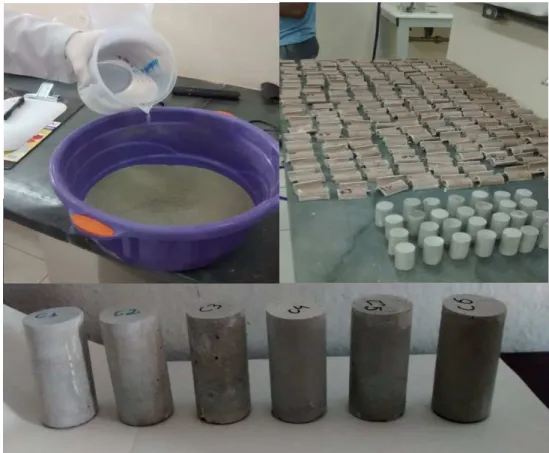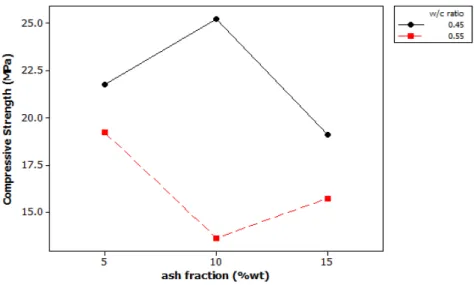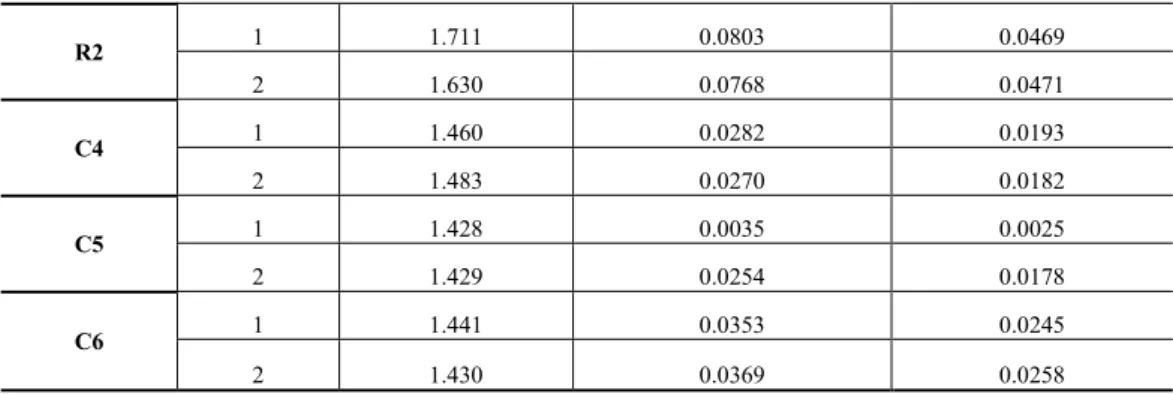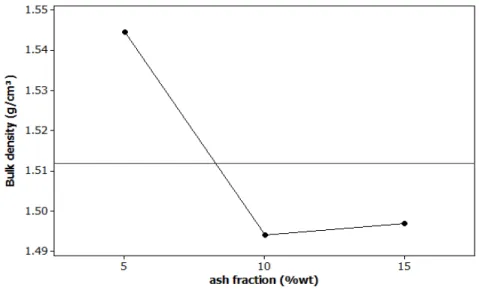ISSN 1517-7076 artigo e-11836, 2017
Autor Responsável: Islane Santos Data de envio: 21/03/2017 Data de aceite: 17/05/2017
10.1590/S1517-707620170002.0169
Effect of the chemical attack on the properties
of cimentititous composites with partial
substitution of ash from sugar cane
bagasse in natura
Islane Santos 1, João Pedro Lages Rodrigues¹, Clareana Gusmão Ramos¹, Carolina Coelho Martuscelli¹, Ugo Nogueira Castañon¹, Verônica Christina Corrêa Alves¹, Gabriel Mendes Abreu¹
1
Instituto de Ciência, Engenharia e Tecnologia, Universidade Federal dos Vales do Jequitinhonha e Mucuri - ICET/UFVJM, Teófilo Otoni, CEP:39803-371, Minas Gerais, Brasil. E-mail: islanesal@gmail.com,
joaope-dro.ecv@gmail.com, claregusmao@live.com, carolina.martuscelli@ufvjm.edu.br, ugo.castanon@ufvjm.edu.br, veronica-christina@hotmail.com, gabrielmendesa@gmail.com.
ABSTRACT
Seeking the reutilization of waste from agriculture and urban sources, studies have presented an option in the inclusion of such waste into new low-cost materials that are environmentally viable. One possibility is the reutilization of sugarcane bagasse ashes (SBA), the final waste in the productive process of the Brazilian alcohol sector. In addition to the behavior of materials with the use of SBA as additions in cement-based materials under normal environmental conditions, the study of the behavior of these materials when exposed to harsh environments is required. Thus, this project evaluated the properties, the compression strength and the bulk density of cement composites with partial replacement of cement by SBA without prior treatment. Also, it analyzed the weight loss and compressive strength of the composites subjected to environments with the presence of chloride ions. A factorial design was adopted to verify the influence of the addition of SBA (5wt%, 10wt% and 15wt%) and water/cement ratio (0.45 and 0.55) in the studied properties. The interaction between the factors was significant. The values obtained from the compressive strength of the manufactured composites showed that it is possible to replace up to 15wt% of cement for in natura SBA. After a chemical attack with an acid solution of HCl 30%, it could be observed that all materials had a lower compressive strength, which can be explained by the high weight loss suffered by all composites. Based on the results of compressive resistance, density and weight loss after the attack, it was observed that the mechanical behavior of the composites in relation to the referential conditions were similar. This study showed that it is feasible, in accordance to the studied properties, to use these composites in promoting the partial replacement of ce-ment by this type of waste and its reutilization.
Keywords: Reutilization of waste, composites, mechanical properties, chemical attack, sugarcane bagasse ashes.
1. INTRODUCTION
The necessity of energy generation from renewable resources, especially alcohol, boosted the development in the alcohol sector of Brazilian industry through the production of sugarcane. It is estimated that in Brazil a production of sugarcane processed in the 2015/16 harvest until October reached a total of 480.44 million tons [1].
The growth of ethanol and sugar production is directly related to the increase of volume of residues, the ba-gasse from sugarcane, that are left in this process. According to the National Electric Energy Agency [2] the bagasse from sugar cane is among the main biomass used for energy co-generation in thermoelectric plants, due to the already produced volume and the fact that the harvest coincide with the drought period in some regions of Brazil.
The Union of Sugar Cane Industry (UNICA) [3] states that with reference only to the bioelectricity of sugar-cane, the sugarcane industry now holds 7% of the power in Brazil and almost 76% of the biomass source, being the third most important source of power generation in terms of installed capacity, behind only the water source and thermoelectric with natural gas.
co-generation process, 25 kg of sugarcane bagasse ashes (SBA) are produced. These ashes are being used as fertilizer for crops, but with the large increase and accumulation, the destination becomes a problem to be faced. The ashes containing silicon dioxide have pozzolanic characteristics, depending on the burning condi-tions and the size of its grains [5,6]. Considering these characteristics, the SBA becomes an important mate-rial which may be used as fine aggregate or as partial replacement in cement-based matemate-rials [7-11].
In the search of the reutilization of SBA with its insertion in the production of pastes, mortars and concrete, it is necessary and indispensable to evaluate the behavior and the ability of these new materials to resist under normal conditions and when exposed to aggressive environments. Thus, this study aimed to evaluate the properties of compressive resistance, and density of cementitious composites with partial replacement of cement by SBA in natura, and evaluate the weight loss and compressive resistance when they are subjected to chemical attack acid (HCl 30%).
2. MATERIALS E METHODS
The cementitious composites have as matrix phase one cementitious paste, and a dispersed phase consisting of ash from sugar cane bagasse. The cement used was Portland cement CPV ARI and was provided by Cauê industry. The sugar cane ash was obtained from Nutritiva Agroindustrial Ltda. company, located in Montes Claros – MG, Brazil.
The sugar cane ashes in natura were adopted in the preparation of the composites. The ashes were classified by the grain size, and were used the passers in the sieve with opening 80 US-Tyler. After the siev-ing, they were dried in an oven set at 60°C for 24 hours.
Figure 1: Composition of the studied material.
2.1 The Experimental Design
The statistical method of design of experiment (DOE) and analysis of variance (ANOVA) provides the mean-ing of each experimental factor in the studied answers. A full factorial design nk are realized to investigate all possible combinations of experimental factors (k) and their levels (n). The results of the nk factorial corre-sponds to the number of experimental conditions investigated [12].
In the present study used the statistical software Minitab version 16 for the processing and analysis of results, as of mentioned method.
Table 1: Experimental Conditions.
Experimental conditions Factors
Ash fraction (%wt) water/cement ratio
R1 - 0.45
R2 - 0.55
C1 5 0.45
C2 10 0.45
C3 15 0.45
C4 5 0.55
C5 10 0.55
C6 15 0.55
2.2 Fabrication of Samples
The fabrication of the samples was manually conducted by mixing the materials based on the experimental setup shown in table (Table 1). The specimens were fabricated using polymeric cylindrical molds of dimen-sions 25.6 mm diameter and 51.2 mm in height. Six samples and two replicates were made for mechanical testing and four samples were used for the bulk density calculate and for weight loss analysis. After 28 days of curing, the samples were removed from the molds and tested.
The chemical attack was made using hydrochloric acid (HCl) in aqueous solution with concentration of 30%. The composites were immersed in solution for 72 hours in a closed container and then washed in water to remove the excess of acid. So, they were dried in an oven at 60 ° C for 7 days.
The compressive strength tests were performed according to recommendations of the standard NBR 7215, using a digital electric press (brand Solocap) with maximum load of 1000 kN. The bulk density was deter-mined by the ratio between the weight and volume of the dried sample (after 24h in an oven at 60°C). To determine the weight loss, the samples were weighed before and after the chemical attack.
3. RESULTS AND DISCUSSION
The table 2 shows the results of analysis of variance (ANOVA), for the average of the variables responses investigated to composite. It were used replication, making possible the obtainment of a more accurate esti-mate of the effects.
Table 2: Analysis of Variance (ANOVA).
P-VALUES ≤ 0.05
FACTORS
NORMAL CONDIDIONS CHEMICAL ATTACK
Compressive
Strength Bulk Density
Compressive Strength
Bulk
Density Weight Loss
Main Factors
Ash fraction 0.035 0.000 0.020 0.003 0.068
w/c ratio 0.000 0.000 0.000 0.000 0.000
Interaction of Factors
Ash fraction * w/c
ratio 0.002 0.098 0.002 0.505 0.093
R²(adj) 96.37% 96.13% 92.55% 96.67% 95.64%
3.2 Compressive Strength
The P-value (0.002) underlined and bold in the table (Table 2) show that the interaction of ash fraction fac-tors and relation w/c were significant and therefore will be analyzed. The results for apparent density can also be seen in table 3.
Table 3: Results of Compressive Strenght
CONDITIONS REPLICATE COMPRESSIVE
STRENGTH (MPa) STANDARD DEVIATION (MPa) COEFFICIENT OF VARIATION
R1 1 30.489 2.9098 0.0954
2 28.211 1.8904 0.0670
C1 1 26.318 2.8454 0.1081
2 25.462 3.7149 0.1459
C2 1 27.051 6.7054 0.2479
2 28.089 6.3061 0.2245
C3 1 28.272 5.9591 0.2108
2 27.347 6.2877 0.2299
R2 1 24.869 3.8218 0.1537
2 23.682 3.4751 0.1467
C4 1 23.630 4.2740 0.1809
2 21.204 4.3939 0.2072
C5 1 17.723 2.2956 0.1295
2 16.318 4.6275 0.2836
C6 1 16.405 2.8264 0.1723
2 15.707 3.5822 0.2281
respectively for R2. Thus it can be seen that the condition 3 (C3) had higher mean values of compressive strength.
Figure 3: Plot of the interaction effect between ash substitution and w/c ratio on the mean compressive strength.
The figure 3 shows that the composites obtained with the w/c ratio of 0.45 presented higher mean value of compressive strength for all percent of ash analyzed. Inverse behavior was observed when using the w/c ratio of 0.55, which can be explained by the excess water which enables exudation in the manufacturing process. Thus, there is an increase in the porosity of the material, resulting in the loss of their resistance, similar be-havior exhibited by conventional cementitious binders.
Figure 4: Compression strength test.
3.3 Bulk Density
Table 4: Results of Bulk Density
CONDITIONS REPLICATE BULK DENSITY (g/cm³)
STANDARD DEVIATION (g/cm³)
COEFFICIENT OF VARIATION
R1 1 1.828 0.048 0.0263
2 1.854 0.0504 0.0272
C1 1 1.837 0.0122 0.0066
2 1.852 0.0221 0.0119
C2 1 1.814 0.0249 0.0137
2 1.833 0.0221 0.0121
C3 1 1.800 0.0505 0.0281
2 1.793 0.0723 0.0403
R2 1 1.658 0.0243 0.0147
2 1.707 0.0517 0.0303
C4 1 1.789 0.0034 0.0019
2 1.791 0.0748 0.0418
C5 1 1.734 0.0611 0.0352
2 1.740 0.0686 0.0394
C6 1 1.723 0.0454 0.0264
2 1.738 0.0287 0.0165
Figure 5 shows the graph of the main effect w/c on the bulk density of the composite. When comparing the average bulk densities for the w/c ratio, it were observed that the composites with w/c 0.55 presents a reduc-tion of 3.79% compared to values obtained with w/c ratio of 0.45. The increase in pore due to the excessive amount of water can explain the reduction in density of materials as observed, proposing that the relation w/c of 0.45 was enough for cement complete hidratation.
In the figure 6 it is possible to analyze the main effect of gray fraction in the density of the composite. It is observed that the higher the cement replacement for ashes, the lower the density displayed, it can be explained by difference in density between the cement and the replacement material, once the sugar cane ash has lower bulk density than the cement.
Figure 6: Main effect plot of ash fraction for the mean bulk density.
3.4 Compressive Strength after Chemical Attack
The compressive strength reductions presented after chemical attack to the references R1 and R2 analyzed were approximately 19% and 13%. The conditions C3 and C5 were approximately maximum 35% and min-imum 10% of reduction of the compressive strength after the chemical attack, compared to the values pre-sented before the attack for the studied composites. as can be seen in table 5.
Table 5: Results of Compressive Strenght after Chemical Attack
CONDITIONS REPLICATE COMPRESSIVE
STRENGTH (MPa) STANDARD DEVIATION (MPa)
COEFFICIENT OF VARIATION
R1 1 26.571 0.8021 0.0302
2 26.754 1.0613 0.0397
C1 1 20.384 1.8404 0.0903
2 23.141 3.1064 0.1342
C2 1 25.768 2.4920 0.0967
2 24.695 2.8966 0.1173
C3 1 19.110 3.6702 0.1921
2 19.145 0.0494 0.0026
R2 1 19.415 1.0736 0.0553
2 20.541 2.6655 0.1298
C4 1 19.058 4.5536 0.2389
2 19.389 0.4565 0.0235
C5 1 14.619 2.6676 0.1825
2 12.653 1.5302 0.1209
C6 1 16.414 2.9354 0.1788
The composites showed maximum percentage reduction least 23% and 4% in the mean compressive strength of the composite after etching with respect to the references.
The P- value (0.002) underlined and in bold in table 2 show that the interaction of ash fraction factors and w/c ratio was significant in post chemical attack compressive strength response.
Figure 7: Plot of the interaction effect between ash substitution and w/c ratio on the mean compressive strength after chemical attack.
Figure 7 shows that composites with 5wt% substitution fractions showed higher compression re-sistance values for the two levels of the w/c studied when compared to composites with 15wt% SBA. An increased compressive strength in composites with 10wt% SBA and the w/c of 0.45, equating the composite consisting of 5wt% and 15wt% cement replacement by SBA was observed, however the materials made with respect to w/c 0.55 showed opposite behavior to that fraction of replacement. The compressive strength val-ues after etching for all composites constituted ratio w/c of 0.55 were lower than those presented for the rela-tionship 0.45, similar behavior to present for the composite before being submitted to chemical attack.
3.5 Bulk Density after Chemical Attack
The volumetric density decreases presented after chemical attack for analyzed references R1 and R2 were approximately 13% and 2%, conditions C6 and C1 have presented about 19% of maximum values and 12% of minimum values reduction of this property after chemical attack, compared to values presented before the attack for the studied composites. as can be seen in table 6.
Table 6: Results of Bulk Density after Chemical Attack
CONDITIONS REPLICATE BULK DENSITY (g/cn³)
STANDARD DEVIATION (g/cm³)
COEFFICIENT OF VARIATION
R1 1 1.612 0.0027 0.0017
2 1.214 0.0156 0.0129
C1 1 1.614 0.0145 0.0090
2 1.621 0.0097 0.0060
C2 1 1.574 0.0496 0.0315
2 1.545 0.0683 0.0442
C3 1 1.545 0.0538 0.0348
R2 1 1.711 0.0803 0.0469
2 1.630 0.0768 0.0471
C4 1 1.460 0.0282 0.0193
2 1.483 0.0270 0.0182
C5 1 1.428 0.0035 0.0025
2 1.429 0.0254 0.0178
C6 1 1.441 0.0353 0.0245
2 1.430 0.0369 0.0258
The composites have presented maximum percentage reduction of about 14% and minimum of 2% in the average density of the composite after chemical attack according to the references. By analyzing the ef-fects of the chemical attack on the volumetric density, it is observed that the P-value (0.000 and 0.003) un-derlined and in bold in the table 2 becomes statistically significant the main factors, especially the interaction did not show statistically significant results.
Figure 8: Main effect plot of w/c ratio for the mean bulk density after chemical attack.
It is noted that the increasing of the w/c ratio has provided decrease in the values of the volumetric density of the composite after chemical attack as shows figure 8. This effect can be explained by the greater weight loss shown by the composites with w/c ratio of 0.55, of this material when compared to composites with the w/c ratio of 0.45.
The figure 8, shows that materials with lower mass replacement by the SBA cement, have presented higher densities when compared to composites of higher amounts of analyzed replacement fraction, this result is analogous to that reported in bibliography [13], which attributes this decrease to increased levels of voids and the relative density of the ash towards the cement. This behavior is similar to that observed in the volumetric density of the composites before the chemical attack.
Figure 9: Main effect plot of ash fraction for the mean bulk density after chemical attack.
3.6 Weight Loss
By analyzing the Table 2, it is seen that only the main effect w/c ratio was significant about the weight loss of composites investigated.
The increase in weight loss of the composites analyzed for its reference, ranged from 0.29% to 10.87% for R1 and between 5.78% and 11.63% for R2. Since the condition 1 (C1) showed less weight loss, similar to the reference condition, as can be seen in Table 7.
Table 7: Results of Weight Loss
CONDITIONS REPLICATE WEIGHT LOSS (%)
STANDARD DEVIATION (%)
COEFFICIENT OF VARIATION
R1 1 14.953 0.2569 0.0172
2 15.157 0.2882 0.0190
C1 1 15.268 0.3829 0.0251
2 14.797 0.2825 0.0191
C2 1 15.964 0.7423 0.0465
2 16.455 1.1927 0.0725
C3 1 16.286 1.0207 0.0627
2 16.579 0.4144 0.0250
R2 1 19.109 1.0399 0.0544
2 18.623 2.9411 0.1579
C4 1 19.496 0.3141 0.0161
2 19.903 0.3002 0.0151
C5 1 20.613 1.1124 0.0540
2 20.427 2.1801 0.1067
C6 1 19.028 0.4774 0.0251
The figure 10 shows the graphic of main effect w/c about the weight loss of the composites submitted to chemical attack.
The increase in 25.01% of the weight loss observed in the conditions with w/c ratio of 0.55 is possibly due to the increased availability of chloride ions because of the high porosity of the material.
0.55 0.45
20
19
18
17
16
w/c ratio
W
e
ig
h
t
L
o
s
s
(
%
)
Figure 10: Main effect plot of w/c ratio for the weight loss.
4. CONCLUSIONS
This paper investigates the effect of substitution of sugarcane bagasse ash in cement composites, considering the influence of w/c ratio. The values obtained for the response variables of manufactured composites showed that replacement of up to 15wt% of cement by SBA in nature is possible. The addition of ashes in the compound causes a general decrease of the parameters analyzed. The increase in water in the ratio w/c also negatively affect the results. However, it can be seen that the compressive strength of the samples made with 15wt% of ash and the ratio w/c 0.45 showed very little variation compared to baseline condition, which shows that the material it has a behavior close to optimal for this type of composite. After the chemical attack which was performed with an acid solution of 30% HCl, it was observed that all the materials had lower resistance to compression, which can be explained by the high weight loss suffered by all composites. How-ever, from the results of compressive strength, density and weight loss after the attack, it was observed that the mechanical behavior of the composites with respect to the reference conditions were similar. This study showed that with the use of these composites is possible promoting the partial replacement of cement by this type of waste from its reuse.
5. BIBLIOGRAPHY
[1] AQUINO, D.F. CONAB - COMPANHIA NACIONAL DE ABASTECIMENTO,
http://www.conab.gov.br/OlalaCMS/uploads/arquivos/15_11_20_17_54_30_cana_de_acucar_outubro_2015. pdf. Acessado em junho de 2016.
[2] ANEEL - Agência Nacional de Energia Elétrica, Atlas de Energia Elétrica do Brasil, Editora Brasília, 2008.
[3] ÚNICA – União da Indústria de Cana-de-Açúcar, A bioeletricidade da cana em números. 2017. Disponí-vel em: <www.unica.com.br/download.php?idSecao=17&id=38583365>. Acessado em maio de 2017.
[4] FIESP/CIESP, Ampliação da oferta de energia através da biomassa (bagaço da cana-de-açúcar), São Paulo, FIESP/CIESP, 2001.
[5] PAULA, M.O., Potencial da cinza do bagaço de cana-de açúcar como material de substituição parcial de cimento Portland, Dissertação de M.Sc., UFV, Viçosa, MG, Brasil, 2006.
[6] NUNES, I.H.S., VANDERLEI, R.D., SECCHI, M., et al., “Estudo das características físicas e químicas da cinza do bagaço de cana-de-açúcar para uso na construção”, Revista Tecnológica, v. 17, n. 1, pp. 39-48, 2008.
[7] PAYA, M.V. J, MONZO, J, BORRACHERO, M.V., et al., “Sugar-cane bagasse ash (SCBA): studies on its properties for reusing in concrete production”, Journal of Chemical Technology and Biotechnology, v. 77, i. 3 pp. 321-325, 2002.
[8] LIMA, S.A., SALES, A., CORDEIRO, S.G.F., PEREIRA, M.G.F., “Análise de contaminantes em co n-cretos produzidos com a cinza do bagaço de cana-de-açúcar em substituição ao agregado miúdo”, In: 53º IBRACON (Congresso Brasileiro de Concreto), Florianópolis, SC, 2011.
[9] LIMA, S.A., SALES, A., MORETTI, J.P., et al., “Análise de argamassas confeccionadas com a cinza do bagaço da cana de açúcar em substituição ao agregado miúdo”, Revista Tecnológica, Edição Especial EN-TECA, pp. 87-97, 2009.
[10] SOUSA, L.R.L., FIGUEIREDO, E.P., RÊGO, J.H.S., “Caracterização de compósitos de cimento com substituição de cinzas de bagaço de cana-de-açúcar (CBC) em diferentes teores”, In: 51º IBRACON (Con-gresso Brasileiro de Concreto), Fortaleza, CE, Brasil, 2010.
[11] SOUTO, J.M.F., VANDERLEI, R.D., NUNES, I.H.S., “Avaliação da cinza do bagaço de cana -de-açúcar em substituição parcial de cimento Portland na produção de concretos”, In: 51º IBRACON (Congresso Brasileiro de Concreto), Curitiba, SP, 2009.
[12] WERKEMA, M.C.C., AGUIAR, S., “Planejamento e análise de experimentos: como identificar e aval i-ar as principais vi-ariáveis influentes em um processo”, Belo Horizonte, Fundação Christiano Ottoni, Escola de Engenharia da UFMG, 1996.
[13] SILVA, R. B., FONTES, C.M.A., LIMA, P.R.L., et al., “Cinzas de biomassa geradas na agroindústria do cacau: caracterização e uso em substituição ao cimento”, Ambiente construído, v.15, n.4, pp.321-334, 2015.









